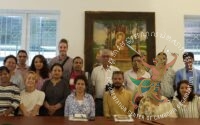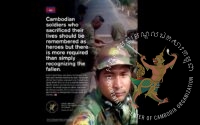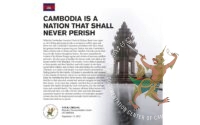Khmer Rouge History Study Session for PSE Students

On Monday, July 7, 2025, around forty Grade 10 students from Pour un Sourire d’Enfant (PSE) participated in a study session held at the Queen Mother Library and the Documentation Center of Cambodia. The students, who came prepared with thoughtful questions and a strong interest in the history of the Cambodian Genocide, engaged in open discussions with the researchers.
Pour un Sourire d’Enfant (PSE) is a non-governmental organization in Cambodia that has been working since 1995 to lift children out of poverty through education and vocational training programs. This study session is part of PSE’s broader commitment to helping children fulfill their potential through meaningful learning opportunities.
Divided into three groups, the students participated in themed sessions led by DC-Cam’s senior staff and researchers: Dr. Ly Sok-Kheang, Pheng Pong-Rasy, and So Farina. The thematic topics presented included: (1) Khmer Rouge History; (2) Justice and Peace; and (3) The Reconciliation Process in Cambodia (1979–2007), prior to the establishment of the Khmer Rouge Tribunal. These study sessions are part of an effort to strengthen educational responses to the prevention of genocide.
Dr. Ly Sok-Kheang, a specialist in justice, peace, and reconciliation in Cambodia, stated that “the purpose of these study sessions is to provide knowledge and answer questions related to the history of the Khmer Rouge genocide regime from 1975 to 1979.” He also provided a detailed account of the chronological events in Anlong Veng, the last stronghold of the Khmer Rouge.
“Today’s study helped me find answers to all the questions I had,” said student Loun Phalle. “I’ve learned and understood more deeply about the causes behind the collapse of the Khmer Rouge regime.” Another student, Sok Pov, added, “If possible, I would like to visit the actual site in Anlong Veng district to study it firsthand.”
Another group attended a session led by Pheng Pong-Rasy, a researcher who compiled “Village Stories of the Khmer Rouge Years,” which focused on the real-life experiences of survivors of the Khmer Rouge genocide. In order to answer important questions about that period, students must engage with both the personal stories of survivors and the historical documents available at the library.

“I’ve learned more about Cambodian history and now encourage all students to be understanding, tolerant, and united,” said Sok Solida, a student. Another student, Loy Vanny, added, “This is the kind of place that offers the knowledge and books about the Khmer Rouge regime that I’ve always wanted to explore further.”
During the session, a student asked, “What was the purpose of the Extraordinary Chambers in the Courts of Cambodia (ECCC)?” and “What were the benefits of liberation from the Khmer Rouge regime?” These were just two of more than forty questions raised by students throughout the study sessions.
Rather than simply providing answers, the researchers equipped the students with the tools needed to think critically about the questions. Many responses addressed the benefits of liberation from the Khmer Rouge regime, with one key benefit highlighted by So Farina being the restoration of the ‘Right to Life’ after the regime.
The session went beyond just answering questions or giving lectures since it encouraged students to reflect on how they might respond to such atrocities and work toward preventing genocide in the future. “This experience is really valuable for my further studies,” expressed by student Oul Kim-Song. The study sessions concluded with a tour of a panel exhibition on the chronology and process of the Khmer Rouge Tribunal over a 16-year period, presented by Ros Sampeou, the Director of Archives at the Queen Mother Library. This exhibition provided additional materials and information to help answer the students’ questions. Beyond the study sessions, students are welcome to visit the center and library anytime to conduct their own research. “I really want to join the study sessions again because I want to learn more about Cambodian history and help share this knowledge with the next generation,” said Yean Lyhav, a student.
Four decades after the fall of the Khmer Rouge Genocide Regime, many students still ask, “Why did the Khmer Rouge exist?” or “How did the Khmer Rouge fall?” Answering these questions requires more than simple or concise explanations, it demands critical thinking, analysis, and reasoning grounded firmly in historical facts.
For decades, the Documentation Center of Cambodia has been documenting the history of the Khmer Rouge regime. These records have been used in the prosecution of Khmer Rouge leaders.
After the Khmer Rouge took power on April 17, 1975, and collapsed on January 6, 1979, approximately two million lives were lost due to murder, forced labor, and starvation during this three-year and eight-month period, according to Article 1 of the Law on the Establishment of the ECCC (2004). “After studying this, I felt deep sorrow for the people who lived through that time,” said Sok Yi, a student.
At least five senior leaders of the Democratic Kampuchea regime, who were held most responsible for its crimes, have been convicted and sentenced to life imprisonment. “Studying the history of Democratic Kampuchea will help future generations prevent the rise of such regimes,” said San Kimsaan, a teacher.
“Thank you for providing us with this opportunity today,” said student Rin Chenda.

Date: July 7, 2025
Text by: Lyhour Sreang




